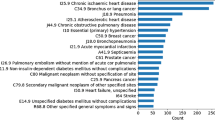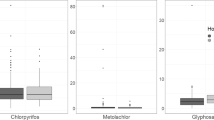Abstract
Hygiene surveys of pollutants exposure data can be analyzed by analysis of variance (ANOVA) model with a random worker effect. Typically, workers are classified into homogeneous exposure groups, so it is very common to obtain a zero or negative ANOVA estimate of the between-worker variance (σB2). Negative estimates are not sensible and also pose problems for estimating the probability (θ) that in a job group, a randomly selected worker's mean exposure exceeds the occupational exposure standard. Therefore, it was suggested by Rappaport et al. to replace a non-positive estimate with an approximate one-sided 60% upper confidence bound. This article develops an alternative estimator, based on the upper tolerance interval suggested by Wang and Iyer. We compared the performance of the two methods using real data and simulations with respect to estimating both the between-worker variance and the probability of overexposure in balanced designs. We found that the method of Rappaport et al. has three main disadvantages: (i) the estimated σB2 remains negative for some data sets; (ii) the estimator performs poorly in estimating σB2 and θ with two repeated measures per worker and when true σB2 is quite small, which are quite common situations when studying exposure; (iii) the estimator can be extremely sensitive to small changes in the data. Our alternative estimator offers a solution to these problems.
This is a preview of subscription content, access via your institution
Access options
Subscribe to this journal
Receive 6 print issues and online access
$259.00 per year
only $43.17 per issue
Buy this article
- Purchase on Springer Link
- Instant access to full article PDF
Prices may be subject to local taxes which are calculated during checkout

Similar content being viewed by others
Notes
TLV=threshold limit value; a health-based concentration to which nearly all workers may be exposed without adverse effect.
TLV–TWA=threshold limit value, with respect to 8-h time-weighted average, that should not be exceeded during any part of the working day.
References
Kromhout, H., Symanski, E., and Rappaport, S. M. A comprehensive evaluation of within- and between- worker components of occupational exposure to chemical agents. Ann Occup Hyg. (1993) 37: 253–270.
Lyles, R. H., Kupper, L. L., and Rappaport, S. M. Assessing regulatory compliance via the balanced one-way random effects ANOVA model. J Agric, Biol Environ Stat. (1997) 2: 64–86.
Peretz, C., Goldberg, P., Kahan, E., Grady, S., and Goren, A. The variability of exposure over time: a prospective longitudinal study. Ann Occup Hyg. (1997) 41: 485–500.
Preller, L., Kromhout, H., Heederik, D., and Tielen, M. Modeling long-term average exposure in occupational exposure–response analysis. Scand J Work, Environ Health. (1995) 21: 504–512.
Rappaport, S. M., Lyles, R. H., and Kupper, L. L. An exposure assessment strategy accounting for within- and between-worker sources of variability. Ann Occup Hyg. (1995) 39: 469–495.
Searle, S. R., Casella, G., and McCulloch, C. E. Variance Components. Wiley, New York. 1992.
Wang, C. M., and Iyer, H. K. Tolerance intervals for the distribution of true values in the presence of measurement errors. Technometrics. (1994) 36: 162–170.
Williams, J. S. A confidence interval for variance components. Biometrica. (1962) 49: 278–281.
Acknowledgements
We acknowledge Liesbeth Preller from Wageningen University, the Netherlands, for providing the pig farmers exposure data set.
Author information
Authors and Affiliations
Corresponding author
Rights and permissions
About this article
Cite this article
PERETZ, C., STEINBERG, D. Improved non-negative estimation of variance components for exposure assessment. J Expo Sci Environ Epidemiol 11, 414–421 (2001). https://doi.org/10.1038/sj.jea.7500182
Received:
Published:
Issue Date:
DOI: https://doi.org/10.1038/sj.jea.7500182



